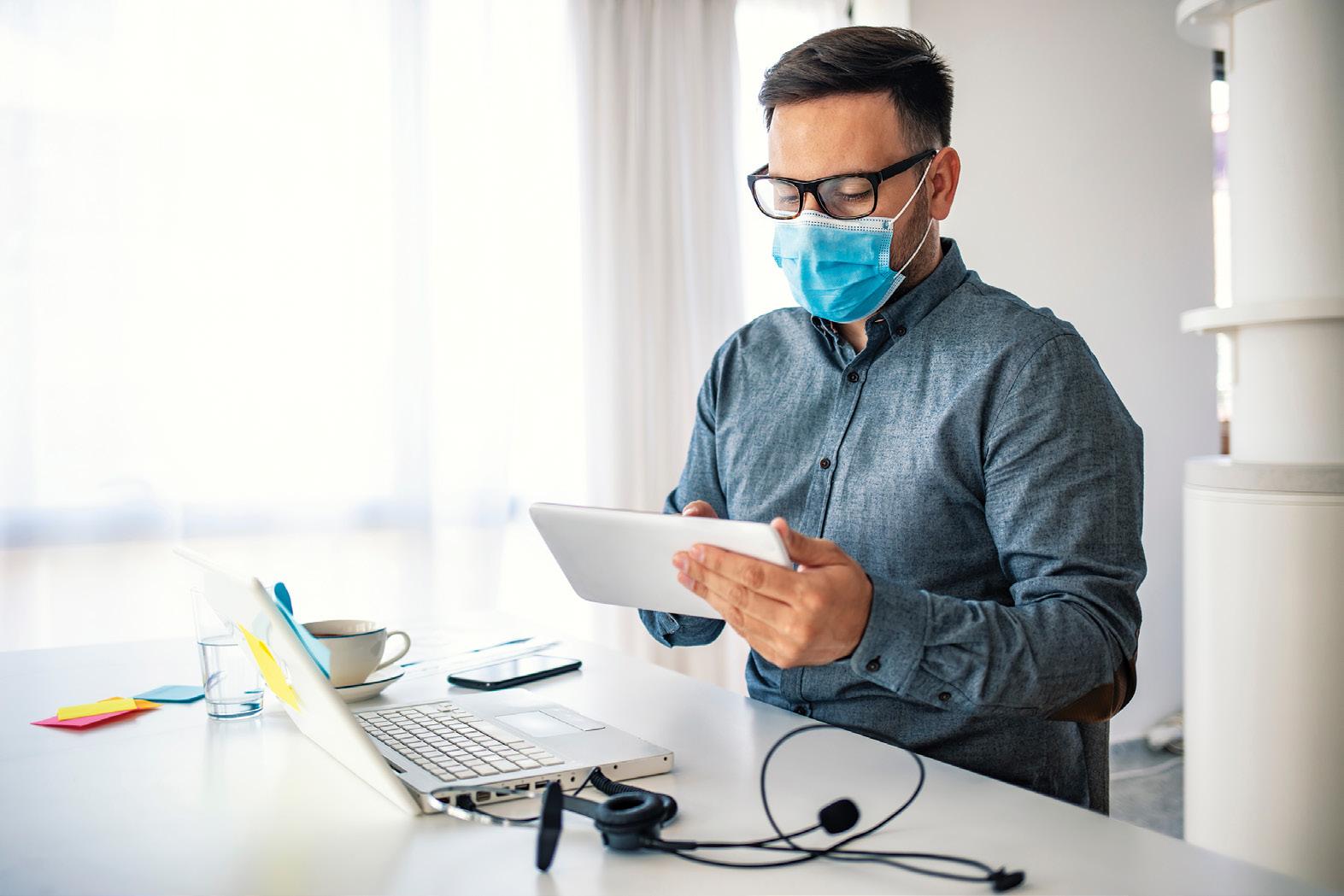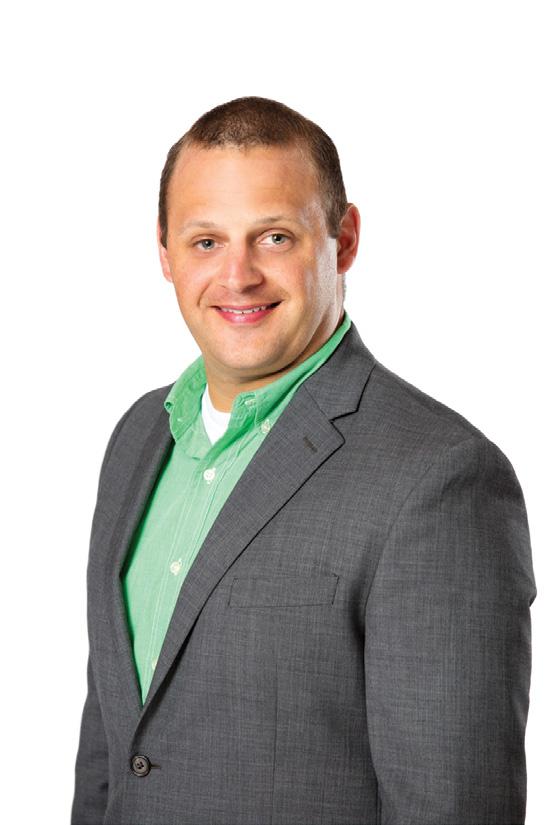
9 minute read
Accounting for the new normal


From large public firms to businesses to higher education, the COVID-19 pandemic is reshaping the accounting world.
By Ken Wysocky
From video- and teleconferencing with clients to working remotely to adopting workplace social distancing practices, accounting officials statewide are grappling with the “new normal” imposed by the COVID-19 pandemic. At the same time, whether they’re working in private accounting firms, industry or academia, CPAs also find themselves resigned to one of the few certainties posed by the virus going forward: uncertainty. “We’re going to have to remain fluid about whatever we do,” said Ben Hauser, CPA, the president of Northland CPAs in Rhinelander. The company also operates offices in Woodruff and Tomahawk and has about 14 employees. “It’s anything but definitive what the rest of the year will look like, much less tax season 2021. We’re watching things like a hawk.” Ben Hauser “You can’t be married to one particular protocol,” said Matt Schaefer, CPA, CGMA, vice president of the Bank of Wisconsin Dells. “You have to keep looking at the risk factors and adapt as needed.” Interviews with nearly a half-dozen CPAs showed that approaches to workplace protocols vary by location, size and type of business. Matt Schaefer

Working the phones
Take Northland, for example: Like many other businesses nationwide, the firm initially closed its offices to clients in midMarch. Then it shifted to virtual tax consulting, using phone conferencing. Disruption was minimal, Hauser said. “Quite honestly, teleconferencing has worked out just fine,” he said. “Our clients totally respected what we were doing to keep them and our employees safe.” By mid-June, the firm had reopened to the public. Staff and visitors aren’t required to wear masks, but visitors are advised to not enter if they have any of the symptoms listed on a sign by the front door. Bottles of hand sanitizer also are available by the door. And because eight of the nine employees in the Rhinelander office have their own offices, social distancing already was in force, Hauser said. “It’s different up here in Oneida County,” he explained. “We haven’t had that many cases, which made us feel more comfortable about reopening. “But all staff members have the option to work from home if they don’t feel comfortable at work. I think it’s important to keep that option out there,” he added. “We already had a few people who self-quarantined because they had family members who took spring-break vacations.” To replace on-site work with clients, Northland started using a software program called LogMeIn. The software enables Northland employees to remotely access clients’ computers in much the same way that IT technicians can take control of computers and fix problems from far away. “The pandemic forced us to get creative, and thankfully we have the technology to provide services remotely in an effective manner,” Hauser said. “LogMeIn allows us to help clients do things such as adjust payroll entries and provide QuickBooks support. Our clients have been very pleased with it.”
Stark contrast
Things are very different at the much larger Milwaukee office of KPMG, where roughly 115 employees still are working from home, while a handful of essential employees might go to the office a day or so a week, said Joe Rock, CPA, the office managing partner.
Joe Rock
“We’re still planning a phased reopening of our offices,” he said. “But historically speaking, we’re comfortable working outside our offices — and we have the technology to keep doing that. So it hasn’t been massively disruptive because we’re already used to working like this.” Depending on the size of virtual meetings, the firm has been using technology such as Skype, Microsoft Teams and Webex. “It’s all pretty amazing technology and very easy to use,” he said. The firm’s 80-page return-to-office “playbook” calls for a measured reappearance of employees, Rock said. “We’re not blasting the offices open,” he explained. “We’ll start with the 10% of employees who need to come in and see how that goes, and as we learn from that, we’ll gradually open it up to another 25%. But it’s all determined by facts on the ground and is very fluid.” Company officials are still working out how to reconfigure workspaces to accommodate social distancing. The first option calls for using all offices and then limiting seats in cubicle clusters and “team rooms” to create proper distancing, he said. As for wearing masks, taking employees’ temperatures upon coming to work and staggered work shifts, everything is under discussion. And no one will be forced to go back to the office if they feel uncomfortable, he noted.
Will KPMG ever have an office filled with employees again? “I’d hate to say no – I think we will,” Rock said. “But I’m not sure if that’ll be pre-vaccine or anytime soon. Our main concern is opening things cautiously and safely. “But I think it’ll be a bit of time before we’re back to normal, and then the question is whether we get back to normal or to a new normal,” he continued. “And I certainly can’t answer that today.”
Banking on best practices
At the Bank of Wisconsin Dells, almost all of the roughly 81 employees in three locations — the headquarters in Wisconsin Dells and two other branch offices in Lake Delton and Portage — returned to work on June 29, having shut down in midMarch, Schaefer said. But in early July, the banks closed again as COVID-19 cases rose. The situation underscores how fluid the situation is and the importance of flexibility. When employees returned to work in June, things weren’t that different compared to pre-COVID-19. Foot traffic in banks was already declining due to online banking, so there was no need to limit the number of customers allowed in the bank simultaneously, he said. Moreover, on an average day, only three of the five teller windows in the Wisconsin Dells branch were open simultaneously before the pandemic. So with a teller sitting at every other window, they already were social distancing, Schaefer explained.

On the other hand, the bank’s branches are complying with best practices provided by public health officials in Sauk and Columbia Counties. That includes social distancing (seating for visitors was reduced by 75%), minimizing touchpoints (a second set of entry doors in the vestibules are kept open at all times so customers don’t need to touch them) and eliminating free coffee and refreshments, he said. In addition, the banks offer a disinfectant station and erected Plexiglass barriers at tellers’ windows. As for wearing masks, there’s no requirement. “We have to be very wary about people wearing masks — and sunglasses — in banks,” Schaefer said.
Educators, students also affected
The world of accounting academia also is facing unprecedented challenges. At the University of Wisconsin–Whitewater, about 780 students are enrolled in the accounting program. That’s down slightly compared to last year, said D’Arcy Becker, CPA, MBA, PhD, chairperson of the accounting department and an
D’Arcy Becker accounting professor. “It’s very hard to predict whether enrollment will go up or down [by the time school starts],” she said. “Ultimately, most classes would transfer if a student decided to attend school elsewhere, but it’s not seamless. There are significant barriers for students who decide at the last moment to go to a different college.” Becker expected that by Aug. 1, officials would know which courses would be taught remotely, in person or in a hybrid manner (a combination of both). But she said one thing is for sure: The class schedule would be the same for both remote and in-person classes. “We want them to feel like it’s a regular school day — to get into that academic rhythm,” Becker explained. “One of the biggest lessons we learned last spring is that students feel less connected to classes and teachers with asynchronous classes … and that students need some regimentation to their school day.”
Distancing is a classroom challenge
Social distancing requirements will make in-person instruction more challenging because seating capacities will decrease significantly. The UW system requires six-foot social distancing; at UW–Whitewater, for example, that means a tiered classroom with a capacity of 66 students will be capped at 16. So what happens if the class has more than 16 students? That’s where the hybrid classes come in. If, for example, 32 students are enrolled in a class with a limit of 16 and that class meets on Tuesdays and Thursdays, half would attend in person on Tuesday and remotely on Thursday and vice-versa for the other half, Becker explained.
“Dealing with all of this will require a lot of flexibility,” she noted. “We’ve been spending a lot of time this summer trying to figure out the best and most appropriate way to use the campus because everyone coming to every class on campus just isn’t an option.” Furthermore, students may not visit professors’ offices, and faculty will be required to wear cloth masks in class. The university is expected to provide each student with two or three reusable masks, she said. “Masks are difficult in two ways,” Becker pointed out. “One, it’s become a political issue; and two, availability can be an income issue. Not everyone has access to a sewing machine to make their own masks, and because the rooms get hot, a student might need to wear three masks during one class, so it can get expensive.” Amid all the disruption and challenges, there’s one small silver lining: Accounting is not as complicated to teach remotely as many other subjects. “It’s quantitative … there’s a process, an order to it that makes it easier to teach remotely,” Becker said. “Another saving grace is that accounting students tend to be excellent students,” she continued. “They’re very diligent and pursue information, especially upper-division students. Accounting students are among the best students at the university.”
Technology to the forefront
Looking ahead, there’s little doubt that COVID-19 has changed the accounting profession and accounting education. But Hauser believes that even if things are never quite the same again, that’s not all bad. “I’m convinced that the events of this year will really change the way small and medium-sized accounting firms will do business going forward — maybe even for larger firms, too,” he said. “The pandemic has almost forced some technological advances onto our clients — and some of them find virtual meetings are quite nice. “I think that during the 2021 tax season, we’ll also have fewer face-to-face tax appointments in our office and fewer on-site services as a result of COVID.”
Ken Wysocky is a freelance writer based in Whitefish Bay. Contact him at 414-962-6202 or kenwysocky@gmail.com.

The Finance Committee of the WICPA Board has reviewed and approved the WICPA audited financial statements for the fiscal year ended April 30, 2020. The WICPA Educational Foundation Board has reviewed and approved the audited WICPA Educational Foundation financial statements for the fiscal year ended April 30, 2020.








